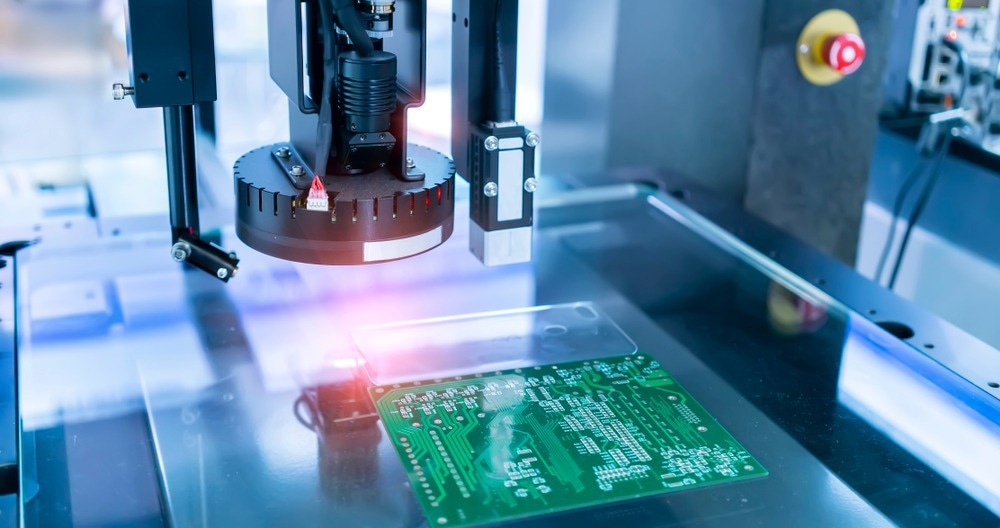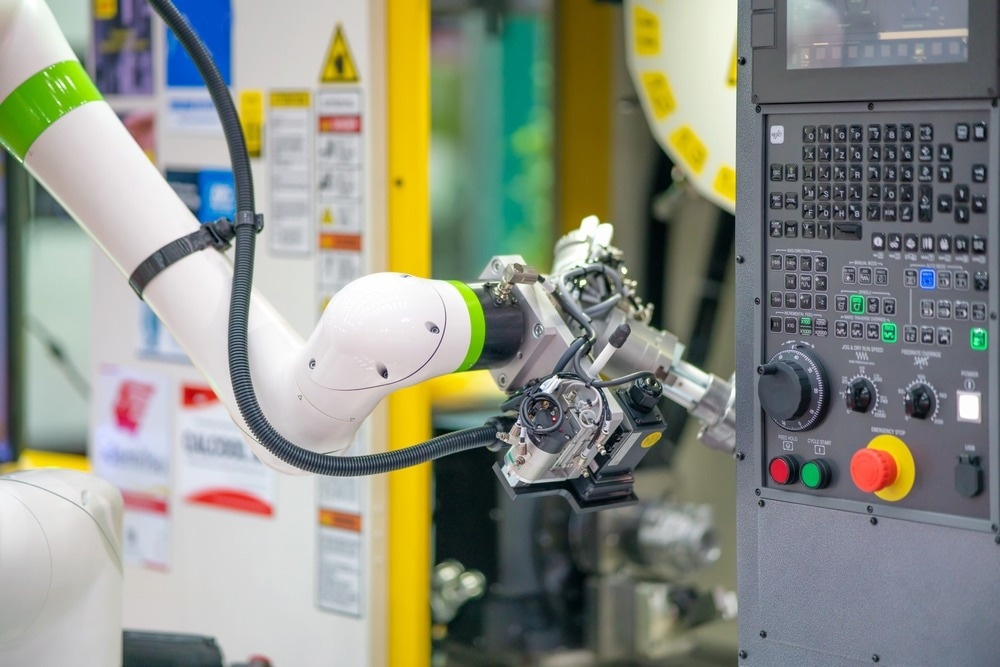Download as a PDF for Offline Reading.
Electronic quality control in modern manufacturing is crucial for ensuring reliability, with robotic systems playing a significant role in enhancing precision and efficiency, conducting precise inspections, and enabling predictive maintenance, despite facing challenges like high costs and integration difficulties. For more on the advancements and challenges in electronic quality control, continue reading.

Image Credit: asharkyu/Shutterstock.com
Why is Electronic Quality Control Essential?
The need for electronic quality control has become increasingly important because of the ongoing challenge of reliability faced by manufacturers of complex electronic equipment. Consequently, there has been a shift towards using quality control methods to ensure reliability, which encompasses predictability and suitability.
Quality control management oversees production and combines process control and inspection functions. It encompasses a comprehensive process that covers all specification, production, and inspection phases to provide products with desired consumer characteristics.
Assessing a product's mechanical and electrical aspects and ensuring that it meets statistical uniformity standards are essential components of product quality. However, predictability alone does not guarantee that a product meets customer needs. Therefore, comprehensive quality control aims to achieve both predictability and suitability of the product while considering the customer's requirements and ensuring that it is economically feasible.
Steps Involved in Electronic Quality Control
The quality control process entails several stages, such as statistical control measures, feedback mechanisms, and ongoing improvement procedures, all aimed at aligning product features with consumer desires. As a result, electronic quality control goes beyond mere consistency, as it strives to provide products that not only meet but also surpass customer expectations.
Benefits of Robots in Electronic Quality Control
Robots have increasingly become a significant component of quality control, improving the quality assurance of electronics manufacturing by ensuring precision and efficiency. By employing a robotic-mediated quality control process, manufacturers can reliably maintain product consistency while simultaneously addressing the intricate challenges of production requirements.
Robotics is frequently used in automated inspection systems in electronics manufacturing. These systems employ robots equipped with high-resolution sensors and cameras to carry out precise inspections of products while they progress along the production line.
For instance, in the electronics industry, robots are used to conduct precise inspections on circuit boards. These robots are equipped with cutting-edge vision systems that enable them to promptly identify any defects, such as missing components or misalignments, which would otherwise be time-consuming and subject to human error.
Robotic systems can incorporate data analysis tools, facilitating predictive maintenance. These systems can identify minute variations in equipment performance or product quality, thus enabling operators to address potential concerns before escalating to significant issues.
Integrating robotics into electronic quality control processes has led to a substantial change in the direction of streamlined, dependable, and precise manufacturing practices, enabling industries to introduce faultless electronic goods into the market.
Challenges Robots Face in Electronics Quality Control
Intelligent inspection is a transformative force in the electronics industry. However, its successful integration into the workflow remains a challenge. The high cost of robots and their maintenance and upgrading over time are significant hurdles.
In addition, companies often encounter difficulties integrating these robots with their existing systems and processes, including employee training, compatibility issues, and data management. Finally, there may be regulatory and legal barriers to overcome, as some industries have strict guidelines regarding automation and robotics.
Collaborative Robots (Cobots) in the Electronics Industry
In the electronics industry, the most common tasks automated by cobots are product testing and quality control. With the help of a cobot, chips can be inserted into testing machines and sorted. In addition, cobots are perfect for soldering printed circuit boards. Because of their precision and built-in sensors, which allow them to work delicately, cobots are ideal for handling fragile products. This reduces the margin of error and increases the efficiency and productivity of the production process.

Image Credit: August Phunitiphat/Shutterstock.com
Accurate Surface Defect Detection in Electronic Manufacturing
Accurate surface defect detection is essential for maintaining high-quality control standards in electronic manufacturing. Defective products can result in significant customer complaints, thereby highlighting the importance of this process.
High-resolution input images captured by industrial cameras are necessary to satisfy the strict requirements of high-quality control standards. Therefore, developing a real-time object detector with high accuracy that can handle high-resolution inputs is critical in the electronics manufacturing industry.
A recent study published in Scientific Reports reported the fabrication of an accurate You Only Look Once (YOLO)- style object detector. The detector was constructed with a single self-attention module, a backbone that incorporated multiple-scale feature extraction and integration, and an enhanced auto-anchor design to tackle this particular issue.
The dataset utilized in this research project consisted of 14,478 images of defects found on laptop surfaces. The findings revealed that attention (ATT)-YOLO achieved a mean average precision (mAP) 0.5 of 92.8% in the binary-class object detection task. Additionally, the design was assessed using the COCO benchmark dataset.
Upon comparing the computational costs and performance with other contemporary and lightweight object detectors, it was evident that ATT-YOLO demonstrated exceptional performance on the common objects in the context (COCO) dataset.
The model achieved an mAP score of 44.9% and a performance of 21.8 GFLOPs, which surpassed the capabilities of other state-of-the-art models. This research provided a useful reference for applying attention-based networks in real-world scenarios.
Conclusion
To summarize, electronic quality control has become an essential component of modern electronics manufacturing processes, as it helps to ensure reliability during intricate production procedures. Incorporating robotic systems into quality control processes represents a significant breakthrough, particularly for handling intricate components requiring utmost precision.
The absolute necessity of electronic quality control stems from the ongoing problem of dependability encountered by the producers of sophisticated electronic equipment. Hence, implementing quality control measures is crucial for ensuring consistent dependability. Dependability encompasses both predictability and appropriateness, which are attained through statistical quality control and comprehensive feedback mechanisms within a quality control framework.
Robots have revolutionized electronic quality control by enhancing their precision and efficiency. They conduct precise inspections using high-resolution sensors and cameras and swiftly identify defects such as missing components or misalignments. Moreover, robotics enables predictive maintenance by analyzing minute variations in the equipment performance or product quality.
References and Further Reading
Torrey, M. N. (1956). Quality Control in Electronics. Proceedings of the IRE, 44(11), 1521-1530. https://ieeexplore.ieee.org/abstract/document/4051910
Krishna, R. S., & Fernandes, L. J. (2023). An Overview of Collaborative Robots and Their Applications. Self‐Powered Cyber Physical Systems, 309-319. https://doi.org/10.1002/9781119842026.ch17
Javaid, M., Haleem, A., Singh, R. P., Rab, S., Suman, R. (2022). Significant applications of Cobots in the field of manufacturing. Cognitive Robotics, 2, 222-233. https://doi.org/10.1016/j.cogr.2022.10.001
Wang, J., Dai, H., Chen, T., Liu, H., Zhang, X., Zhong, Q., Lu, R. (2023). Toward surface defect detection in electronics manufacturing by an accurate and lightweight YOLO-style object detector. Scientific Reports, 13(1), 7062. https://doi.org/10.1038/s41598-023-33804-w
Disclaimer: The views expressed here are those of the author expressed in their private capacity and do not necessarily represent the views of AZoM.com Limited T/A AZoNetwork the owner and operator of this website. This disclaimer forms part of the Terms and conditions of use of this website.